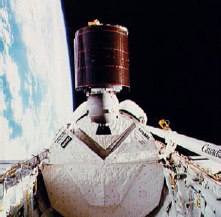1945
Geosynchronous Satellites
Hermann Oberth (1894–1989), Herman Potocˇnik (1892–1929), Arthur C. Clarke (1917–2008)
Newton’s Laws of Gravity and Motion and Kepler’s Laws of Planetary Motion in particular apply to artificial satellites just as well as to planets in orbit around a star or moons in orbit around a planet. Rocket technology and astronautics—the study of navigating through space—advanced quickly after the first liquid-fueled rockets capable of reaching high altitudes were developed in the 1920s by Robert Goddard.
Several of Goddard’s contemporaries were already beginning to think about the mechanics and dynamics of orbital (and beyond) rocket flights. Two of those contemporaries were the Hungarian-German physicist Hermann Oberth and the Austro-Hungarian rocket engineer Herman Potocˇnik, who expanded on and worked out the details of concepts first described by the Russian mathematician Konstantin Tsiolkovsky. One of those concepts was the idea of a geostationary, or geosynchronous, orbit.
A satellite in a geosynchronous orbit will complete one orbital revolution in the same amount of time that it takes the Earth to spin once on its axis. From the vantage point of an observer on the Earth’s surface, such a satellite would appear to be parked high in the sky, never moving. Given the Earth’s mass and rotation rate, Newton’s second law can be used to derive the orbital altitude of a geosynchronous satellite—it turns out to be about 22,000 miles (36,000 kilometers) above the surface.

Space shuttle Discovery deploying the AUSSAT-1 communications satellite in 1985.
The British science fiction author and futurist Arthur C. Clarke was one of the first to grasp what would ultimately be one of the most practical applications of such satellite orbits: global telecommunications, described in a 1945 magazine article called “Extra-Terrestrial Relays—Can Rocket Stations Give Worldwide Radio Coverage?” Clark’s popularization of the idea helped it to gain wide attention and support. Starting in 1964, the actual use of geosynchronous satellites has now gone far beyond just radio relays. Today they also relay TV, Internet, and global positioning system (GPS) signals and help us to monitor Earth’s weather and climate.
SEE ALSO Three Laws of Planetary Motion (1619), Newton’s Laws of Gravity and Motion (1687), Liquid-Fueled Rocketry (1926).
A snapshot of satellites currently being tracked by the NASA Orbital Debris Program Office; Earth’s ring of geosynchronous satellites can be clearly seen.
